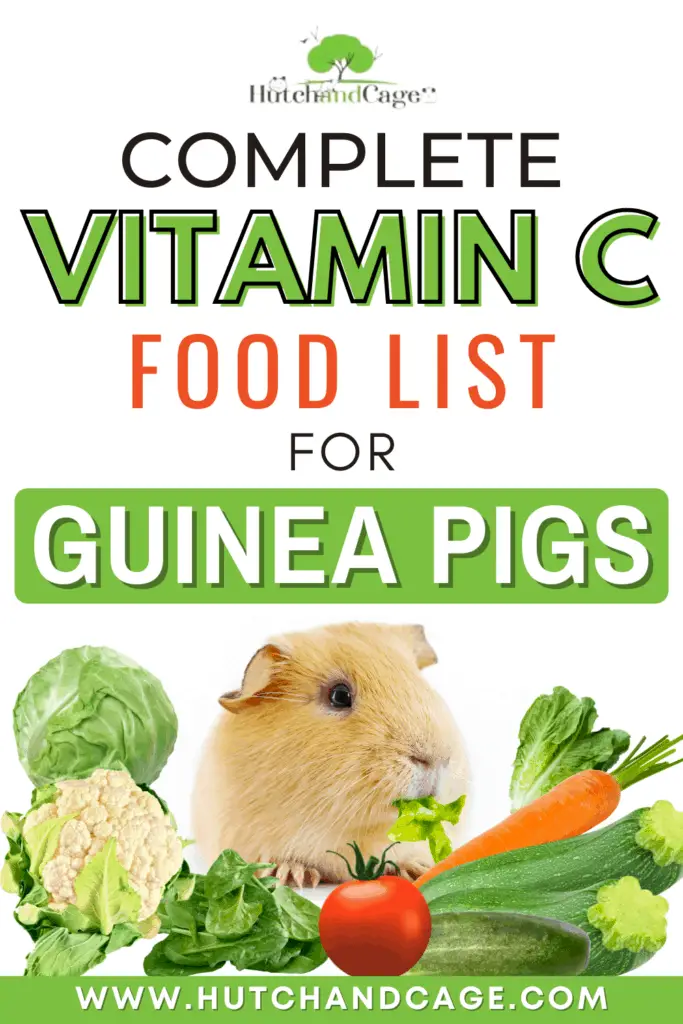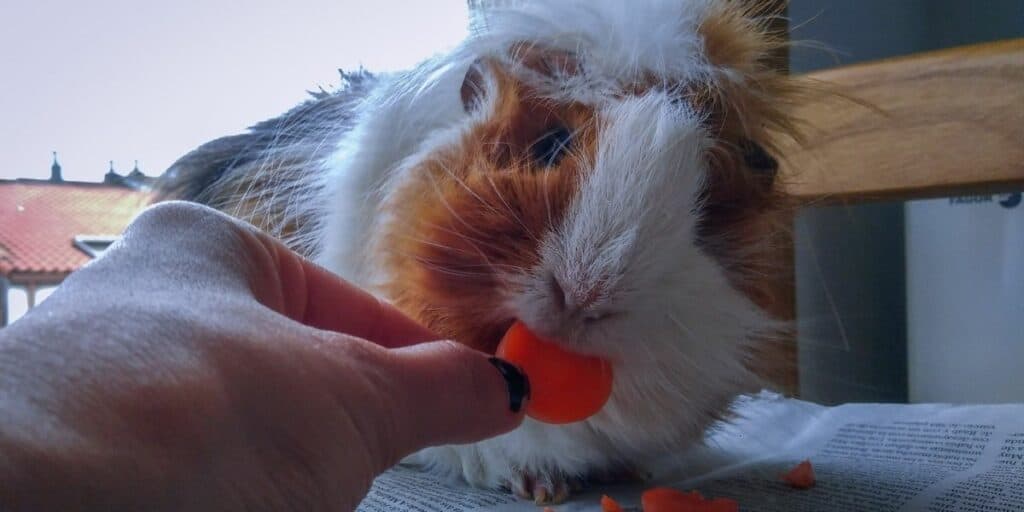We never have to worry about making sure our dog or cat has enough vitamin C in their diet. This is because most animals are able to make their own vitamin C, although the ones who can’t include most primates, and humans.
Surprisingly, guinea pigs are also on the list of animals who cannot make their own vitamin C. Because it’s a vital component to their physical health, guinea pigs have to ingest plenty of foods that are rich in this important vitamin.

In the wild, they’d forage for it themselves, but when we keep them as pets, they rely on us to do that for them. Don’t worry, though, because with this complete vitamin C food list for guinea pigs, you’re sure to be giving them exactly what they need.
Table of Contents
Why is Vitamin C So Important?
We need different vitamins from our diets in order for our bodies to perform certain functions. Vitamin C’s function is to keep our immune systems strong, and to maintain healthy cells, bones and tissue.
This is the same for both us as humans and our beloved guinea pigs. Without enough vitamin C in our diets, we lose the ability to fight off infection, which leaves us more susceptible to disease.
Always Make Sure He has a Supply of Hay
Good quality hay and grasses are a must. They make up almost 80% of a guinea pig’s diet and contain the fiber he needs.
We use Timothy Hay which you can purchase from Amazon. Here is a link to the one we buy.
Those that are rich in dandelion, marigold and chamomile also contain vitamin C and are the kinds of grasses that your guinea pig would eat if he was living in the wild. However, they don’t stay fresh in his cage for more than a day, so the vitamin C will degrade quickly.

For that reason, you should always keep your guinea pigs topped up with the right amount of vitamin C from other sources.
Will Vitamin C-Enriched Pellets Be Enough?
Commercial feed companies have made life easier for owners by creating pellets that come enriched with vitamin C. These pellets should be a daily part of your guinea pig’s diet because they contain other important ingredients, too.
We like Kaytee Pellet food which can be purchased from Amazon online.
However, the vitamin C inside these pellets doesn’t last very long. Once out of the keep-fresh bag, the vitamin degrades quickly so if your guinea pig doesn’t eat all his pellets (between 1/8 and ¼ of a cup per day, split into two meals) then he will be vitamin C deficient.
He’ll need to be topped up with fresh fruit and vegetables. In the wild, guinea pigs eat grasses and vegetables fortified with vitamins, so you will to be the one to provide him with these extras.
Fresh Vegetables are Perfect and Inexpensive!
You could always invest in vitamin C treats for your guinea pig but there’s really no need. You’ll end up spending far too much cash when fresh vegetables will work perfectly fine.
Not all vegetables should be fed every day. They may contain sugar or too much calcium, so get to know which ones are best and in what quantity.
With all fruits and vegetables, you should remove any uneaten pieces within a few hours of being placed in the cage. They quickly grow harmful bacteria that you don’t want to spread.
These are the kinds of vegetables that you should give your guinea pig, along with suggested portion sizes and feeding timetables:
- Yellow and green bell peppers – 1 or 2 slices, once per day
- Red and orange bell peppers – 1 or 2 slices, 2-3 times per week
- Tomato – 1 or 2 slices, or one cherry tomato, once per week
- Spinach – 2 or 3 small leaves, once per week
- Cauliflower – 2 small florets and 2 small leaves, twice per week
- Cabbage – 2 or 3 leaves, twice per week
- Celery – 1 or 2 slices, with leaves, twice per week
- Cucumber – 1 or two slices, 3 times per week
- Lettuce – 1 or 2 leaves, daily
- Zucchini – 5 or 6 slices (100g), daily
- Broccoli – 1 floret with stem and leaf, twice per week
- Carrot – 2 or 3 slices, three times per week
- Squash/Pumpkin – 1 or 2 chunks, twice per week
You should be aiming to give your guinea pigs half a cup of vegetables per day, made up of a mix of the above. Be careful not to overfeed your guinea pig.
Other vegetables that contain less vitamin C but are still fine to feed as an occasional treat are:
- Dill
- Basil
- Chicory
- Asparagus
- Beetroot
- Coriander
- Parsley

Fruits Rich in Vitamin C
Fruits are excellent sources of vitamin C, but they’re also high in sugar, which can cause problems in other areas, i.e., causing your guinea pig to gain weight or develop kidney problems. Always serve fruit in lower quantities than you would vegetables.
Here, we’ve provided a list of ideal fruits, and with it the serving sizes and frequency to give your guinea pig.
- Apple – 1 piece, once per week
- Pear – 1 piece, once per week
- Strawberry – 1 small strawberry, once per week (include the leaves!)
- Banana – 1 small piece (15g), once per week
- Watermelon – 1 slice, three times per week (seeds removed!)
- Raspberry – 1 small raspberry, twice per week
- Kiwi – 2 slices, once per week
- Orange – 1 orange segment, once per week
- Grapes – 2 small grapes, once per week
- Cherry – 1 cherry, twice per week (pit removed!)
- Blueberry – 1 or two blueberries, once per week
- Pineapple – 1 chunk, once per week
- Peach – 1 slice, once per week
- Apricot – 1 small apricot, twice per week
Remember that this doesn’t mean one of each of these fruits! Just choose one or two from the list in a week, and no more.
Foods You Should NEVER Feed Your Guinea Pig
You should never give your guinea pigs:
- Rhubarb leaves
- Peas
- Avocado
- Onion
- Mushroom
- Corn
Introduce New Foods Slowly
It can be tempting to make up a cup of fresh fruits and vegetables and present them to your guinea pig with love and affection and he may indeed scoff the lot!
However, you should always feed your guinea pig new foods slowly. Introduce one new food a week and see how he gets on with it, and that he doesn’t have any digestion issues.
With this list, you’ll be able to keep him in tip-top health with a robust immune system!
How much vitamin C should I give my guinea pig?
Your guinea pig should be getting about 50mg of vitamin C a day. Fresh vegetables are the best way to give your guinea pig the vitamin C they need.
Can guinea pigs get vitamin C from grass?
Grass, alfalfa, and hay are extremely low in vitamin C. They need the grass, alfalfa, or hay for their diet, but you should include fresh vegetables to give your guinea pig vitamin C.
Should I put vitamin C droplets in my guinea pig’s water?
You shouldn’t put vitamin C in your guinea pig’s water. Vitamin C will quickly lose potency when it is diluted in water. The amount of vitamin C droplets you would need to add to the water would be dangerously high, and if your guinea pig is a little extra thirsty one day, they could be really sick.
Can I give my guinea pig human vitamin C tablets?
You can give your guinea pigs vitamin C tablets from a drug store. If you want to give your guinea pig vitamin C tablets, make sure you buy the chewable variety, and try to buy 80mg tablets. Don’t give them the entire tablet, but cut each one into 4 so your guinea pig is only getting about 20mg.
What happens if a guinea pig doesn’t get vitamin C?
If guinea pigs aren’t getting enough vitamin C, their bodies will become vulnerable to a serious condition called scurvy. If not treated, scurvy can cause a loss of appetite and energy, a rough fur coat, internal bleeding, and death.
Final Thoughts
As you can see the amount of Vitamin C your Guinea Pig receives is actually down to us. As pet owners, we have a duty of care to provide the best environment for our pets and also the best diet and lifestyle.
Take time to consider the. information we have provided above before you buy a Guinea Pig as a pet.





